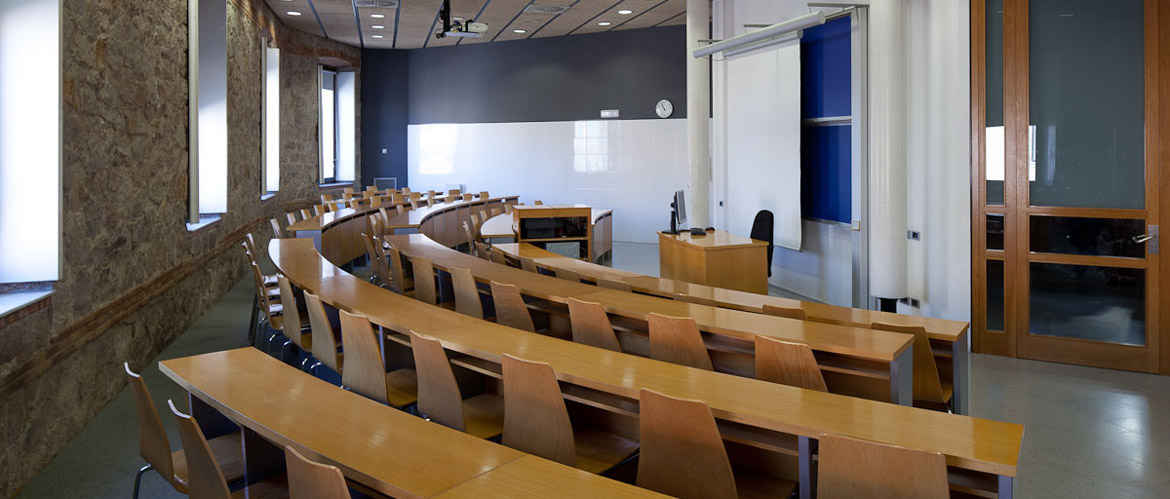Community
2. Community
COVID-19 empties the University’s classrooms
The exceptional situation caused by the coronavirus has forced UPF to become a fully online University, putting the whole community to the test, along with a digital transformation strategy that began 10 years ago
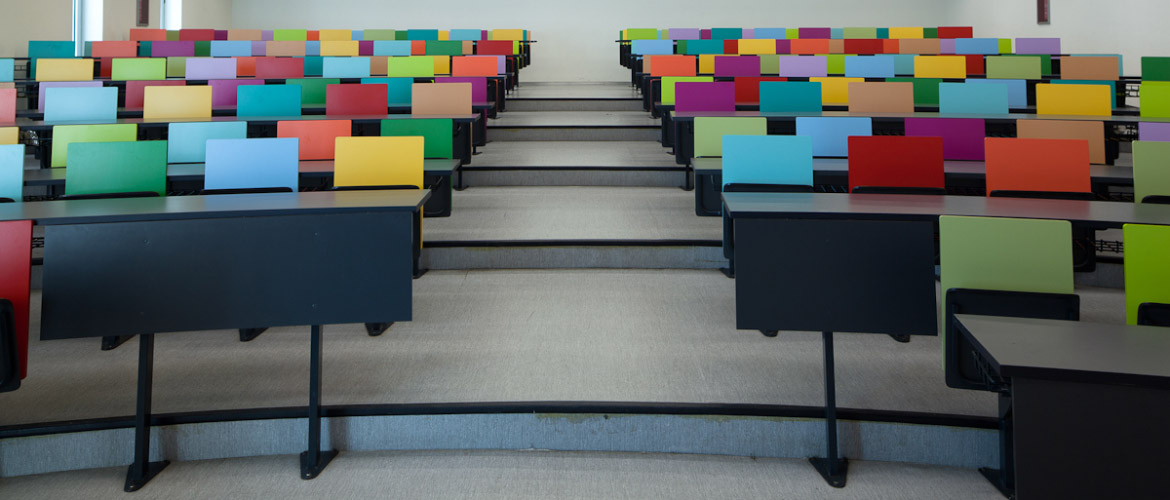
No one could have predicted the magnitude of what has happened. Just 90 days after the world’s first case of COVID-19 in mid-December, Pompeu Fabra University’s campuses, as well as those of every other Catalan university, were closed on 13 March. It took less than three months for a virus, initially not seen as being overly aggressive, to spread uncontrollably across the world, confining billions of people to their homes. It has had and will have far-reaching and lasting consequences.
A cronology of the pandemic
-
First reportes cases in Wuhan (China)
-
First reported death (China)
-
Tailand: first cases outside China
-
Japan: first cases outside China
-
Three first cases in Europe (France)
-
First case in Italy
-
First case in Spain (Canary Islands)
-
First reported death outside China (Philippines)
-
UPF begins informing the university community about the new coronavirus outbreak
-
First case in peninsular Spain
-
UPF creates a web page for information related to COVID-19
-
UPF sets up the COVID-19 monitoring comittee
-
The WHO declares COVID-19 a global pandemic
UPF suspends its face-to-face exams, which where scheduled for 18 to 28 March, and works on developing alternative assessment systems
-
The Spanish government declares a state of alarm and orders the closure of all education centres, among other places
-
UPF undertakes its 2nd term assessments, with some 200 exams sat remotely
-
UPF begins its third term with 100% virtual teaching
-
The number of cases around the world reaches the million mark
-
The number of cases around the world reaches the three million mark
This is a situation without recent precedents, which has taken literally the entire world off guard. Although the effects have been different from country to country, the authorities have coincided in many of the measures they have taken; among them the people’s confinement to their homes.
“We’ve upheld the programme for the year’s academic activity because of the institution’s extraordinary commitment. We’ve got through the first online assessment period and online teaching has begun in the third term as planned for all UPF degrees and masters.”
Specifically, universities have been forced to suspend all face-to-face teaching until the end of the academic year and modify their systems from top to bottom. The change has been an abrupt one, practically from one day to the next, placing immense pressure on all institutions to ensure that the academic year goes ahead as smoothly as possible.
To make matters worse, at UPF, the closure of its campuses came just five days before the beginning of the second term assessments, adding to an already complicated situation and putting the agility and flexibility of all areas of the University to the test. In spite of everything, for Cristina Gelpí, vice-rector for teaching projects, the overall appraisal is positive: “We’ve upheld the programme for the year’s academic activity because of the institution’s extraordinary commitment. We’ve got through the first online assessment period, with around 200 remote exams being sat without incident, which was completed in April. And online teaching has begun in the third term as planned for all UPF degrees and masters.”
At the end of February, the University put together a COVID-19 monitoring committee, formed by a dozen management heads from all areas of the University. This has allowed the situation to be analysed and decisions to be taken regarding the main actions needed to manage the crisis.
In early March, Gelpí says, “we already suspected the situation would be more serious than it appeared, which is why we activated the contingency plan for the second-term exams and online teaching for the third term”. In this case, she adds, “it was a good move to have considered the worst-case scenario, as, when it came to putting the plan into operation, the centres had already foreseen the alternatives that best suited their needs”.
Nevertheless, plans can always go sporadically awry, and the University is always on hand to address situations as they arise: “It is our responsibility to ensure that we uphold our quality standards, which is why we are taking and intensifying all measures necessary for this exceptional term to unfold under the best possible conditions”, stresses Gelpí.
“It is our responsibility to ensure that we uphold our quality standards, which is why we are taking and intensifying all measures necessary for this exceptional term to unfold under the best possible conditions”
But, how do you go from being a face-to-face university to an online one in such a small space of time? Firstly, and in the words of the vice-rector, “it is thanks to having such excellent teams that are fully aware of the exceptional situation we are in, and to students that are also well aware of the unusual times we are all going through”; and secondly, “because we have the technology and methodological tools necessary to run the entire term online”. In fact, one of the key pieces for this plan to work is the role of the IT Service, and especially La Factoria, which has coordinated with the different centres to attend to the supportive needs of the teaching staff and student queries.
A planned digital transformation

The transformation from face-to-face teaching to online in such a small space of time has been possible thanks to the ICT strategy the University has put into action to transfer all applications and infrastructures to the cloud (cloud computing). This strategy began ten years ago in 2010, when the email service was passed over to Google.
For Mercè Cabo, vice-manager of the Services, Technologies and Information Resources Area, “digital transformation is essential for any organization hoping to survive in the future, as it offers a greater competitive advantage in an environment that is constantly changing to keep pace with the evolution of technology”. And this transformation process was specifically established in the Strategic Plan 2016-2025, where it was recognised as one of the drivers of organisational change that would help the University to move forwards and implement an innovative culture.
Some of the most relevant practical examples of this digital transformation are the remodelling of the Aula Global (each subject’s virtual teaching space) in 2017 and the launch of MyApps, in 2018. The latter is a cloud-based platform which provides online access to all the applications that UPF offers its students without the need to download them onto a personal computer.
“The strategy we have followed so far has allowed us to provide accessible, flexible, scalable, effective and efficient environments. The cloud allows us to adapt to the use needs of each moment, increasing or decreasing the consumption of resources quickly and easily"
In the current, unprecedented situation, “the strategy we have followed so far has allowed us to provide accessible, flexible, scalable, effective and efficient environments”, Cabo asserts. And she adds that “the cloud allows us to adapt to the use needs of each moment, increasing or decreasing the consumption of resources quickly and easily based on the University’s needs.”
The statistics say it all. During confinement, the use of technology and specific applications for online teaching and remote study has multiplied exponentially. The increased pressure on the system, however, has not been overwhelming.
Usage data for the week of 30 March - 5 April: first week of remote teaching of the third term
- 102.687
Sessions initiated on the Campus Global from outside UPF (a daily average of 17,000, normally 800).
- 7.212
Remote connections via VPN (a daily averages of 1,200 de mitjana, normally 110).
- 1.443
Video-conferences with Google Hangouts Meet.
- 11.134
Participants in video-conferences with Google Hangouts Meet.
- 1.221
Video-conferences with Blackboard Collaborate (virtual teaching tool).
- 33.589
Participants in Blackboard Collaborate.
- 1.926
Applications used in MyApps.
- 9.340
Degree students that have gone onto online teaching platforms (90,4% of total students).
- 3.830
Number of teaching materials posted on online platforms to date.
These statistics are supported by the organisation of user services (front office) aimed, precisely, at offering a response to situations like the ones that have arisen over these past few months. As the deputy general manager says, “the front offices are structured in such a way as to be able to provide services face-to-face or online, asynchronously and remotely”. Of particular relevance in this regard right now is La Factoria, whose main function is to give support on the virtual, cloud-based teaching platform, in the production of multimedia materials -especially teaching support-, and in the online services.
Essential support for teaching staff
“We cannot deny that to run the third term online also requires a tremendous effort from our teachers, who have to change teaching methodologies, routines and dynamics… and it is vital that the University gives them the right support for that”, says Cristina Gelpí. “Technological tools are a great help, but most of all we need to provide them with the support they need to deal with the changes required to transform a face-to-face subject into one that can be taught virtually”.
How can I run a tutorial session remotely? How can I replace seminar activities with the equivalent non-synchronous activities using the Aula Global? How can I record a video and post it on the Aula so students can access it? What kinds of chat are most suitable for communicating with students? These are just some of the questions that need answering.
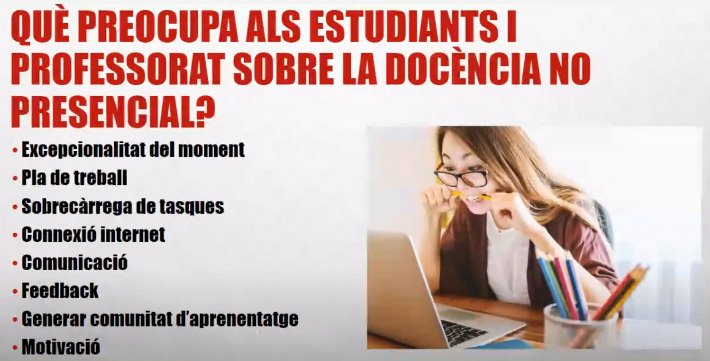
That is why La Factoria, in early March, created a specific web page on virtual teaching and assessment, which contains all the tools available to the University’s teaching and research staff (PDI), as well as all the training and self-study resources, both from UPF and other institutions. It also brings together the management guidelines specifically developed by the University’s different bodies.
Moreover, specific training for PDI has been introduced right from the beginning of the confinement. “We began with a webinar to address the second term exams”, says Anna Magre, head of La Factoria, “and we then did three more to help teachers prepare for online teaching in the third term”. And there was a clearly positive response from the teaching staff with a high level of live participation in each webinar, with between 100 and 200 participants. “And for those who couldn’t attend the live webinars, we made recordings available for everyone on the referring website”. Finally, she adds that “once the teaching staff had access to the webinars and tutorials and all the available tools, we then designed more specific actions in response to questions and queries, which we call La Factoria-CLIK queries webinars”.
Although she admits that not all the teaching staff feel equally at ease when it comes to using digital tools, Anna Magre asserts that “the evolution has been very fast and positive, and in a short space of time the queries have gone from being fairly general in nature, to much more specific, focused on how to take advantage of the many different possibilities of the Aula Global”.
“The evolution has been very fast and positive, and in a short space of time the queries have gone from being fairly general in nature, to much more specific, focused on how to take advantage of the many different possibilities of the Aula Global”
The organisation of the service has also been key to this success, with a strong commitment to remain close to PDI. Not only have the usual hours and channels for providing remote support been maintained, but also a second telephone line has come into operation, along with a video-conference room to reinforce user support regarding more specific queries. The challenge, according to Magre, “has been to respond with maximum speed and efficiency”.
To give an idea of the volume of queries being addressed, between 30 March and 3 April, the first days of the third term, La Factoria responded to 254 calls (51 a day on average), received 331 emails (66 a day on average) and did 53 video-conferences (11 a day on average).
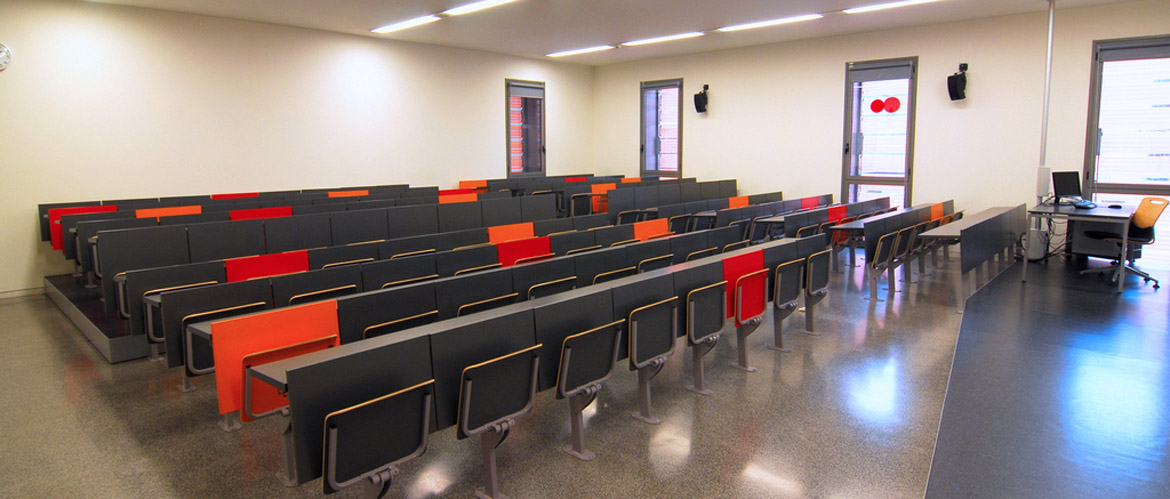
What are the teaching staff's views?
We spoke with teachers from different departments doing online teaching this third term to find out how they have adapted to the changes, what challenges they have had to address and how students have taken to the subject’s new teaching format.
Tamara Djermanovic, lecturer in the Departament of Humanities
Subjects: Aesthetics and Philosophy of Culture, optional subject on the degree in Humanities, and the Subjectivity of Literary Discourse, from the Master in Comparative Studies in Literature, Art and Thought
Horacio Saggion, lecturer in the Departament of Information and Communications Technologies
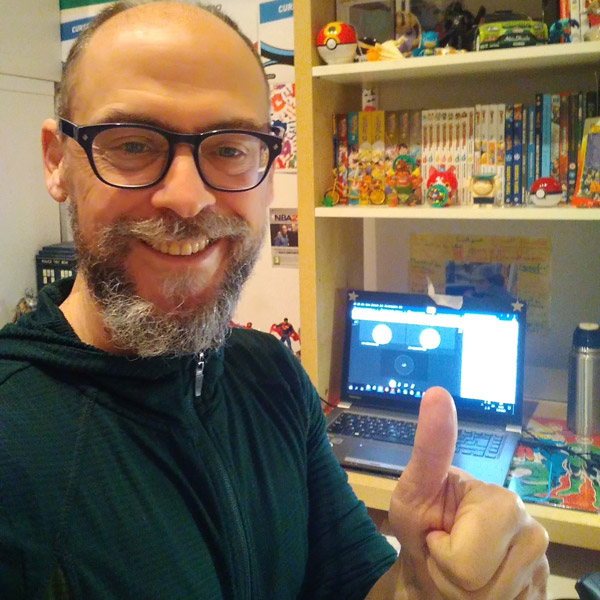
Subject: Structures of Data and Algorithms II, from the first year of the degrees in Computer Engineering, Telecommunications Network Engineering, Audiovisual Systems Engineering and Mathematical Engineering in Data Science
From face-to-face to virtual?
The most complicated issue has been the organisation of a first year course with a large number of students and teachers. To make the course more efficient, teachers from each group now have more responsibility when it comes to organising the Aula Global sessions. In terms of assessment, continuous assessment, which can be done online effectively on a computer programming course like mine, has been less of a concern than the final assessment, which is especially challenging on a first year course where there are a lot of students.
Challenges?
In my case, especially this year, I rely quite heavily on using a whiteboard, which cannot be simulated effectively with the materials I have at home, especially when it comes to writing equations or doing a live maths demonstration. The fact that you can’t see your students also poses an added difficulty in big theory classes, as you can never be sure as to how well the group is following you.
Use of UPF resources?
I have participated in the online training sessions offered at UPF ( La Factoria and USQUID), specifically on the available e-learning tools, like Collaborate, and on the mechanisms for aiding students’ online assessment. The sessions have been really useful, and not only because of what you learn about the tools, but also because of the experience the other participants bring with them.
Possible limitations?
There are undoubtedly many challenges, as there are courses that require special teams to develop practical work and which cannot really be substituted with online experiences. In my case, however, as it’s a programming-based subject, the course can be adapted pretty well to the distance learning format.
The students’ response?
It’s very hard to say at the moment. I think we’ll have to wait a few weeks yet to find out how all this will affect their learning. Especially with so many factors at play. It will also be hard to assess the effects of this virtual learning format. On our course, basically what has changed is the way in which the message is conveyed.
Positive sides?
We’ll have to take something positive from this tragedy. I think that the capacity to adapt to complex situations like this will mean we come out of this stronger. It would be a positive move to invest in preparing our own online material (video lectures, tutorials…) which can be reused in the future. That would not only be positive for our university, but for the whole of society.
Gabriela Pedranti, lecturer in the Departament of Communication
Subject: Analysis of Advertising Messages from the second year of the degree in Advertising and Public Relations
Mar Carrió, lecturer in the Departament of Experimental and Health Sciences
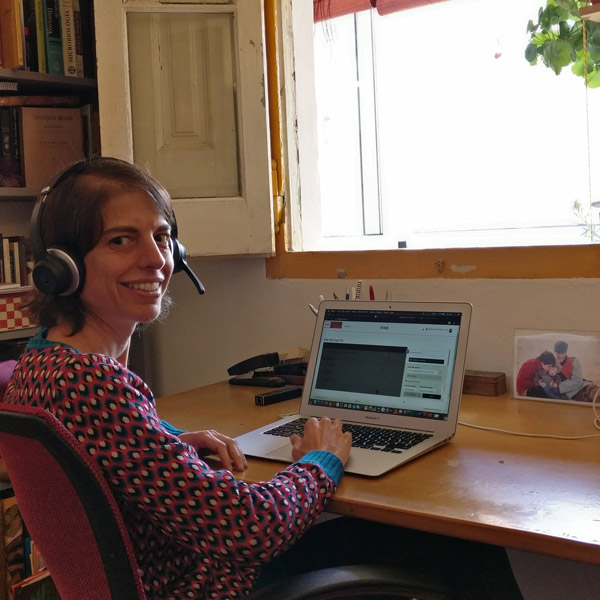
Assignatures: Integrated Biomedicine Integrada III of the degrees in Human Biology and Medicine and Design of Innovative Learning Environments of the Master’s Degree in Teacher Training for Secondary Education
From face-to-face to virtual?
Firstly, I’ve had to rethink a lot of the programmed teaching activities, as we couldn’t do what we’d designed for face-to-face classes in exactly the same way. I’ve also spent a lot of time exploring all the different tools and, especially, preparing new teaching material. It is a lot of work for me, but I’ve learnt about new tools that I think are really interesting for teaching purposes.
Challenges?
For the Masters in Teacher Training for Secondary Education, students were right in the middle of their Practicum when the confinement began, so that all came to a halt. As this is a vocational Masters, the Practicum is fundamental, as it’s where they learn most and where we can see whether or not they have attained the skills necessary to become good teachers. So that has been and continues to be our biggest challenge. In some cases, students have been able to continue their Practicum offering online teaching at secondary schools, but for many that hasn’t been possible. So, we have very different cases to deal with and are seeking out alternatives for assessing teaching competences. In any case, as the department of education has decided that after Easter week, teaching centres will offer online teaching, we’re making every effort for students to finish the Practicum through the virtual format. In addition, we’ve tried to give all the support we can to students in their adaptation to online teaching, which has also meant a lot of work for us.
Use of UPF resources?
Yes. In the third term, I coordinate a subject on the degrees in Human Biology and Medicine, which is structured around a project-based learning methodology, in which students work in groups of eight, with a tutor who guides them through the development of the project. We are doing this using “Collaborate” and the response has been very positive. Students have one tutorial session per week and we leave the “Collaborate” rooms open so they can do group work whenever they want. So far, the experience has been a good one.
I have also tried doing a video with Kaltura and found it to be a very simple process. We have also designed an activity in which students have to post a video presenting a task, which the other students have to watch. We’ll then run a synchronous session with Collaborate to discuss the videos that have been made.
Possible limitations?
The laboratory work has been very difficult to substitute. There are virtual laboratories, which can teach a lot about how certain laboratory techniques work, but not the corresponding manipulative skills. Likewise, it is very hard to do the clinical internships and clinical simulations virtually, which is when the professional skills are fully put into practice.
The students’ response?
So far, the student’s have responded very well. They seem to like having certain synchronous activities when they can interact with students and teachers and discuss aspects of the subject. In any case, I am concerned that not all students have the right conditions for doing this and lack the resources in terms of technology or space. I think we need to be aware that either of these things can pose a barrier to their participation in class.
Positive sides?
Yes. We’ve been talking about cutting back on face-to-face teaching and looking for more flexible learning models for some time now, so I think that this experience will be very useful to help us see which activities need to carry on being given face-to-face, and which can be transformed. We will also be in a much better position to identify and evaluate what limitations we need to bear in mind when implementing these kinds of teaching formats.
Josep Capdeferro, lecturer in the Departament of Law
Subject: Introduction to Common Law of the Degree in Law and the double Degree in Law + Economics/Business Administration and Management
Marta Marfany, lecturer in the Departament of Translation and Language Sciences
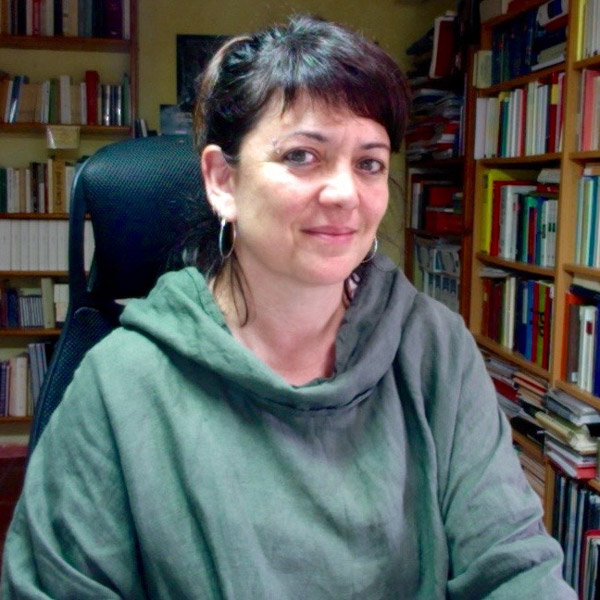
Subjects: Translation between Catalan and Spanish from the second year of the degree in Translation and Interpreting and Literature of the Language (French literature) as an optional subject for this degree
From face-to-face to virtual?
To start with, the switch was stressful and a lot of work, but after the first week of class I began to get to grips with it and realised it might work ok. Like everyone, I’ve had to adapt the entire subject, all the materials and activities that I had prepared. It’s not a question of starting the subject afresh, or of making it virtual, but rather somewhere in between: reinventing it so you can offer students what you had planned (the same content, aims, competences, etc.) and also so, as a teacher on the course, you can feel comfortable with it.
Challenges?
It’s basically all been a challenge, especially finding my way around resources I had never, or hardly ever, used, and having to decide which of these resources could be most useful for a specific activity. The challenge will continue throughout the term. I don’t think any of us have experience in this kind of teaching methodology, which is neither one thing nor the other, so we’ll have to try things as we go, and discard those things that don’t work out. Right now, I couldn’t tell you for sure what’s going to work and what isn’t, which is why I’m saying this is a kind of test period, like a prototype. It has also been a challenge to get used to unusual and uncomfortable situations, like, in the case of Collaborate, having to teach classes from home and let all your students in… It’s like an invasion of your world and at the same time you lose the intimacy of the classroom setting. The classroom is the teacher’s and students’ private space. The Aula Global and resources like Collaborate can be substitutes in certain aspects, but what we call a “class group” can only exist in a physical classroom. We’re missing that, and I think it’s irreplaceable: with Collaborate and other resources you’re addressing individuals, not a class group.
Use of UPF resources?
I have used and will continue to use Collaborate and other tools we have on the Aula Global, like the chat and forum. And I’ll try out others too. I really value the support UPF has given us, from the CLIK, the IT services and the Library. I’ve attended some of the webinars organised by La Factoria-CLIK, some have been useful, others not so, but, as a rule, I always learn something new. Any queries I’ve had for the IT services have been answered there and then and they’ve resolved my issues every time. I’m really grateful to have had that support at such a stressful time.
Possible limitations?
That depends on the subject and the number of students on the subject. This term I’m doing a compulsory translation subject and an optional literary one. I think that in both we could get similar results to the face-to-face versions, but it will undoubtedly entail more work. For example, if you are talking in class about a translation that your students had to do at home, you prepare the translation with all the possible, equally valid solutions, predicting the students’ possible difficulties or mistakes; in a face-to-face class you ask students how they translated this or that sentence, what criteria they’ve used to translate a particular area of terminology, etc.; and the class unfolds based on the students’ responses and interventions. In the virtual version, however, that’s harder to do, students can’t intervene so easily. So, to ensure you achieve the same objectives, one solution is to get students to hand in the translation first, you look through all of them and, based on that, you prepare the class. For the subject I do on French literature, in the face-to-face classes we read Baudelaire, which means just that: read, take a poem and read it in class, start to unravel the meaning, the possible interpretations… Now we have to do all that in a different way, and students can’t participate so much, or at least, their participation is of a different nature.
The students’ response?
The students have responded well to the new format. Most people are aware that this is an exceptional situation, and both teachers and students are doing what we can to adapt. I get the sense that everyone is making an effort, and that is very positive. As regards the changes in how I teach the subject, the main one is that the class isn’t just me talking. I use Collaborate but not the whole time, I combine it with other activities (exercises, video, questionnaires, chat…), because I think an hour and a half of Collaborate would make the group sessions a bit heavy-going. For the hour-long sessions, the seminars, which we haven’t started yet, I think it’s more feasible to use Collaborate throughout. One thing I do miss a lot is the whiteboard, which I normally use a lot (the one on Collaborate is not the same...).
Positive sides?
I honestly think there are. There are tools and resources that I’d never used because I didn’t have the time to spend on them and couldn’t muster the energy to work them out. Now I’ve been forced into learning about and applying them, and some of them I’ll always use now as a complement to my face-to-face classes.
Ricard Zapata, professor in the Departament of Political and Social Sciences
Subject: Citizenship, Immigration and Diversity from the degree in Political and Administration Sciences
A wake-up call for UPF's new education model, EDvolució?
The UPF Strategic Plan 2016-2025 specifies as a teaching strategy, redefining face-to-face education in the learning process:
so as to include the full range of possibilities technology offers today in order to separate the personal interactive and educational processes from processes of discovery and knowledge and to create new spaces for teaching. We must take advantage of all opportunities, both of face-to-face and online teaching and of hybrid methodologies and new models based on inverting the teacher and student roles.
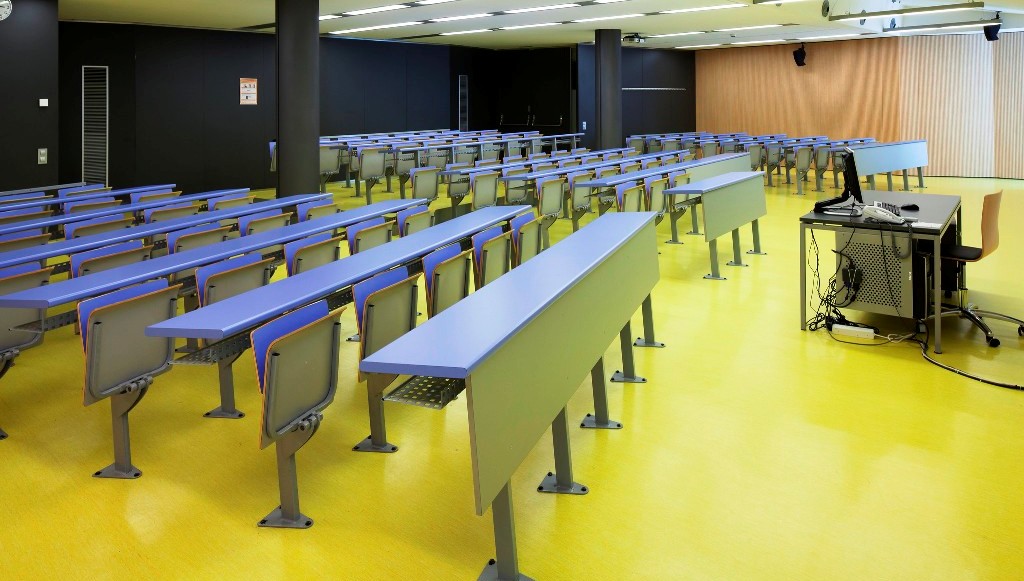
And one of the most irrefutable expressions of this strategy is EDvolució, the new education model that UPF has been working on since 2017-2018 and which, among other things, specifies the need for a reorganisation to adapt the university to an age of digital natives. Fixed work areas need to be removed and replaced with fluid and flexible spaces that enable total mobility and connection, with a key role played by the use of digital environments and applications.
According to Manel Jiménez, UPF’s commissioner for education and communication projects and part of the project’s management team, “the unfortunate situation of being forced into virtuality has led to questions regarding the robustness of distance education; it’s been a reality check that has revealed the imperfections of the current model”. However, he also adds that “the situation has also challenged us and put us in a position where we have had to gradually address the difficulties that arise. With due perspective, it should show us the lessons we have learnt from that”.
"The unfortunate situation of being forced into virtuality has led to questions regarding the robustness of distance education; it’s been a reality check that has revealed the imperfections of the current model”
“EDvolució and UPF had already been working on the idea of a university that was versatile, experiential, cross-disciplinary, diverse, singular and that would set its students apart from the rest. It was doing this before the health crisis began”, says Jiménez, and the University “has proven its capacity to assume this role through the full implementation of its e-learning policy, fast-tracked by the circumstances and still, if we’re honest, with major challenges to resolve, but a long way from the dynamics of an emergency plan for remote teaching”, he adds.
Often, crises, such as the current one, reveal opportunities that we couldn’t have imagined. In this case, for example, the opportunity to align the entire university community, all at once, around the need to explore and make more efficient use of online learning. “Although UPF’s e-learning policy has come a long way - with resource virtualisation, ad hoc teacher training or the production of online learning formats, for example-, this transformation could have gone relatively unnoticed in a day-to-day context”, stresses the commissioner. “But it is this gradual change that allows us to speak confidently about certain principles of EDvolució, and allows us now to consider the viability of concepts like tailoring learning to individual student needs, making teaching models, spaces and time more flexible, blended learning systems to optimise classroom time or the integration of experiences into the students’ curriculum that are not strictly academic”, he asserts.
Despite the difficulties and areas still in need of improvement, Manel Jiménez emphasises that “the efforts and patient collaboration of the entire UPF community are proof alone that we are passing the test, with honours, and that our institution’s education model, its EDvolució, will continue to evolve”.
